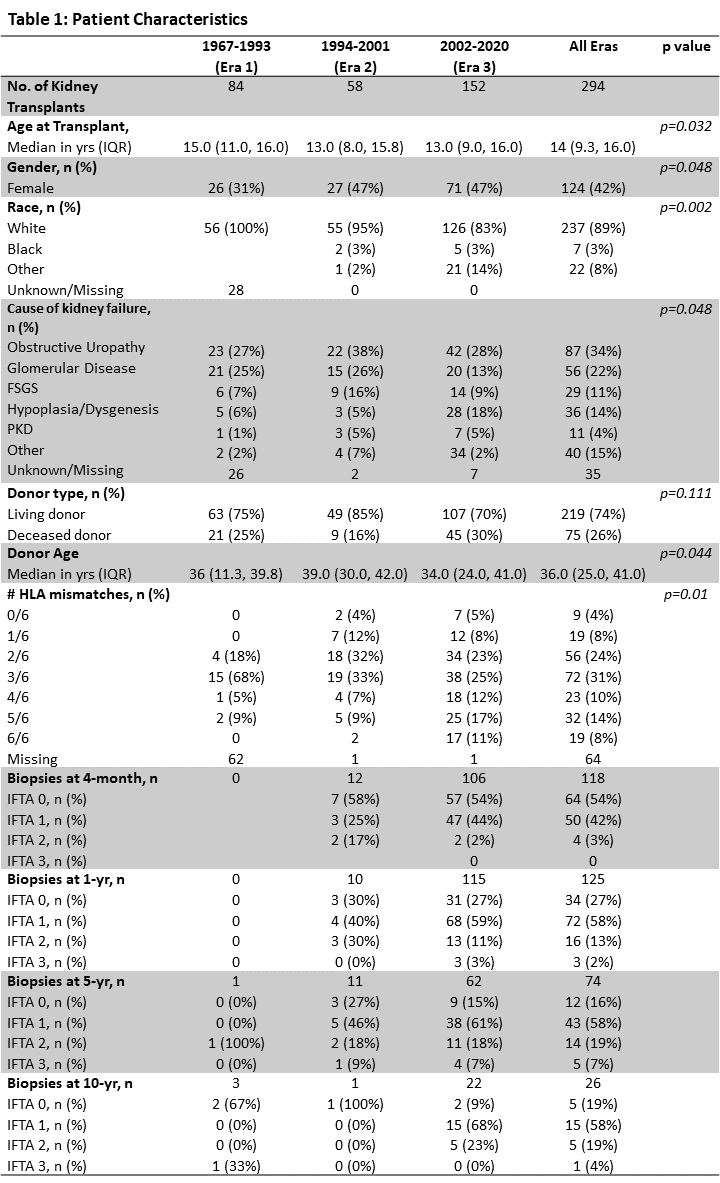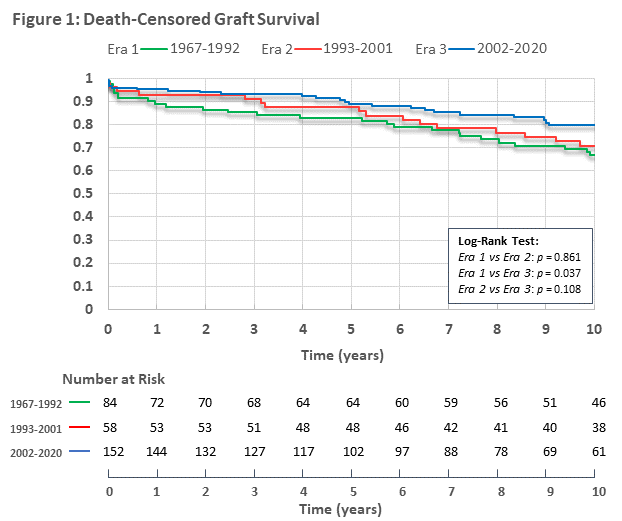Outcomes of Kidney Transplants in Children: A Single-Center Experience
1Nephrology and Hypertension, Mayo Clinic, Rochester, MN, 2Pediatric Nephrology and Hypertension, Nephrology and Hypertension, Mayo Clinic, Rochester, MN, 3Division of Transplantation Surgery, Department of Medicine, Mayo Clinic, Rochester, MN
Meeting: 2022 American Transplant Congress
Abstract number: 840
Keywords: Kidney, Outcome, Pediatric
Topic: Clinical Science » Kidney » 43 - Kidney: Pediatrics
Session Information
Session Time: 5:30pm-7:00pm
 Presentation Time: 5:30pm-7:00pm
Presentation Time: 5:30pm-7:00pm
Location: Hynes Halls C & D
*Purpose: Over the past decades, immunosuppression regimen protocols, surgical techniques, and outcomes in pediatric kidney transplants (PKT) have evolved. This study describes our center’s experience in PKT from inception.
*Methods: We reviewed data of all 294 pediatric patients (age <18 at time of transplant) who underwent solitary kidney transplants at our center between August 1967 and October 2020 (Table 1). We compared transplant characteristics and outcomes in three distinct eras: early (1967-1993), intermediate (1994-2001), and modern (2002-2020). The modern era corresponds to the implementation of protocol biopsies.
*Results: The median age at time of transplantation was 14.0 years (IQR 9.25, 16.0). Obstructive uropathy was the primary cause of kidney failure (34%), followed by glomerular disease (22%). Median follow-up time was 11.0 years (IQR 5.60, 24.5), 14.0 years (IQR 6.50, 21.8), and 8.24 years (IQR 4.23, 12.8) for each of the three eras. One-year death-censored graft survival has improved from 89% to 93% and 95% across the three eras. The primary cause of 1-year graft loss was acute rejection in the first two eras, whereas both recurrent disease and acute rejection contributed equally to 1-year graft loss in the last era. Five-year death-censored graft survival has also improved from 82% to 85% and 88% for each respective era. Graft survival improvement was significant between the first and third eras (Fig 1), and older donor age was a significant risk factor affecting graft survival (p=0.0074). Deceased donor transplantation encompassed 25% of transplants in the early era, compared to 16% in the intermediate era and up to 30% in the modern era.
*Conclusions: Outcomes of PKT have improved over time, with a significant effect of donor age on graft survival.
To cite this abstract in AMA style:
Shaikhouni S, Hanna C, Sekhon I, Amer H, Prieto M, Cramer CH. Outcomes of Kidney Transplants in Children: A Single-Center Experience [abstract]. Am J Transplant. 2022; 22 (suppl 3). https://atcmeetingabstracts.com/abstract/outcomes-of-kidney-transplants-in-children-a-single-center-experience/. Accessed July 18, 2025.« Back to 2022 American Transplant Congress


